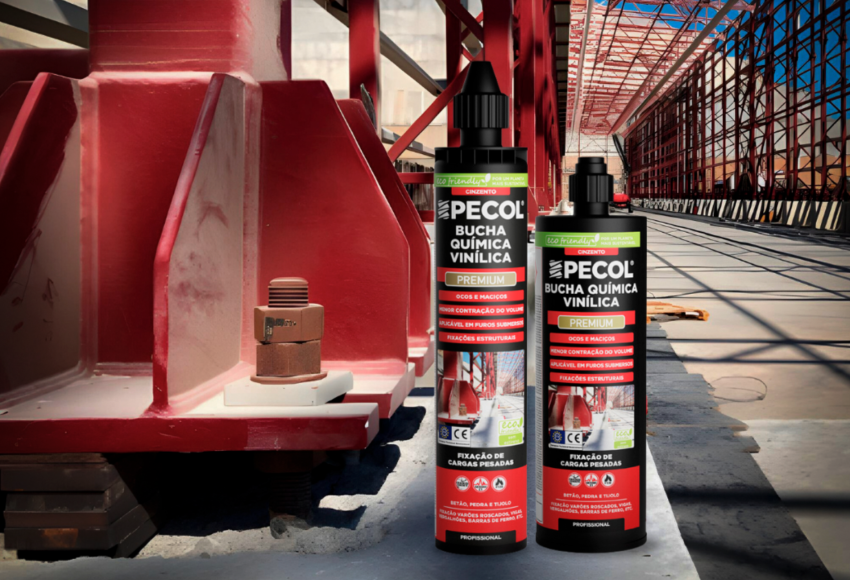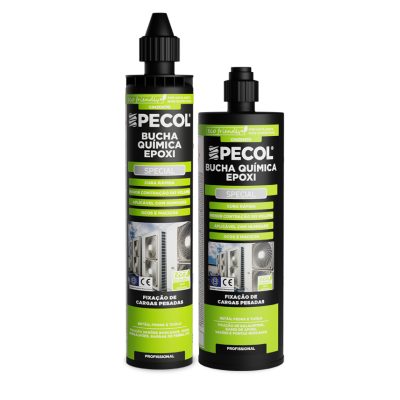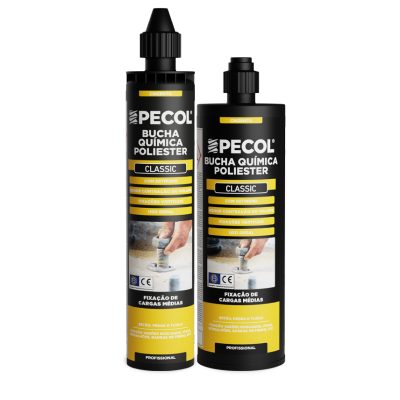
- 11/03/2025
- Tips
Complete Guide to Chemical Anchors
What are Chemical Anchors, How to Use Them, and How to Maintain Them
What is a Chemical Anchor Used For?
Chemical anchors are ideal for securing screws, metal plates (structural or not), and other heavy elements to surfaces like concrete or bricks, both in indoor and outdoor environments, providing superior strength.
The chemical anchoring process uses resin and hardener, which act like glue between the elements to be fixed. This method is perfect for ensuring a robust and durable fixation in porous materials or those that struggle to support conventional fixings.
Types of Chemical Anchors
Pecol offers a range of chemical anchors tailored for various applications:
Vinyl Chemical Anchor
The Vinyl Chemical Anchor is a high-performance fixing solution, ideal for applications in concrete, brick, natural stone, and other solid or hollow materials.
This anchor is designed for demanding fixations on solid and hollow substrates, ensuring high resistance to traction, vibrations, earthquakes, and fire. With ETA certification, it is perfect for structural applications in concrete, natural stone, and brick, allowing for secure anchoring even in adverse conditions. Its thixotropic formula enables precise applications in any position without dripping, while the absence of styrene reduces environmental impact and odor, making it suitable for both indoor and outdoor use.
Epoxy Chemical Anchor
The Epoxy Chemical Anchor is an ideal solution for fixations in solid and hollow substrates, such as concrete, rock, and stone, making it especially useful in situations requiring support for heavy loads. It is recommended for structural applications with reinforced bars in construction and renovation projects. Additionally, it offers high resistance to traction and dynamic loads, and can be applied in both dry and wet holes.
Polyester Chemical Anchor
The Polyester Chemical Anchor is an effective solution for fixations in solid and hollow substrates, such as concrete, stone, perforated brick, and rock. It provides excellent traction resistance and fast curing. Additionally, it has low odor and is thixotropic, allowing for application both vertically and horizontally.
How to Use Chemical Anchors?
Using chemical anchors is simple:
- Check the expiration date, substrate resistance, temperature, and curing time.
- Remove the cartridge cap and attach the mixing nozzle to the gun.
- Discard the first 10ml until the mixture is homogeneous.
- Clean the hole with a brush and blower to remove dust and debris.
- Inject the resin, filling 2/3 of the hole, and insert the fixation element with rotation.
- Remove excess resin and close the cartridge with the cap.
- Apply at temperatures between +5°C and +20°C, ideally at +20°C.
How Long Does a Chemical Anchor Take to Dry?
The drying time for a chemical anchor depends on the resin type used. Generally, initial hardening occurs in 5 to 10 minutes. However, to achieve full strength, the curing process may take up to 24 hours.
How to Store a Chemical Anchor?
Proper storage of chemical anchors is crucial for maintaining their performance. Keep the cartridges tightly closed and store them in cool, dry places away from heat sources or humidity. Avoid exposure to direct light and extreme temperatures, as these can compromise the product’s effectiveness. Always check the expiration date, as chemical anchors may lose their properties over time.
Advantages of Chemical Fixings:
- Safe and durable fixation: Ideal for porous materials and uneven surfaces.
- Versatility: Can be applied to various materials such as concrete, brick, and stone.
- Increased resistance: Supports heavy loads without the risk of detachment.
Chemical anchors are essential for projects requiring secure, high-resistance fixations. Choose the right type for your project and follow the application instructions for optimal performance.
For more information about Pecol’s chemical anchors and to find the right product for your project, visit our online store.
We work together
Discover a world of professional solutions.







